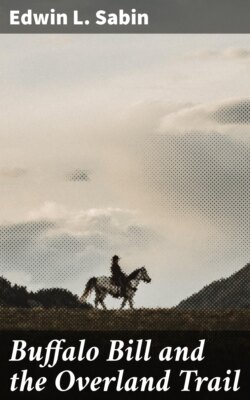Читать книгу Buffalo Bill and the Overland Trail - Edwin L. Sabin - Страница 6
На сайте Литреса книга снята с продажи.
CHRONOLOGICAL TABLE
ОглавлениеTable of Contents
WILLIAM FREDERICK CODY
“BUFFALO BILL”
Celebrated American plains-day express rider, hunter, guide and army scout, who before he was fourteen years of age had won credit for man’s pluck and shrewdness. In his youth a dutiful and helpful son; in his later years an exhibitor of Wild West scenes, with which he has toured the world. Early known as “Will,” “Little Billy,” “Pony Express Bill,” “Scout Bill Cody”; by the Indians termed “Pa-he-haska” (“Long Hair”); but, the globe around, famed as “Buffalo Bill.”
Born on the family farm near LeClaire, Scott County, Eastern Iowa, February 26, 1845.
Father: Isaac Cody. Mother: Mary Ann Cody.
Childhood spent in Scott County, Iowa: at LeClaire and at Walnut Grove.
When eight years old, in 1853, is removed with the family overland to Kansas.
In the Salt Creek Valley, near the Kickapoo Indian reservation and Fort Leavenworth, Eastern Kansas, Mr. Cody takes up a claim and is Indian trader.
Young William is reared among the Free State troubles of 1853–1861, when the slave men and the anti-slave men strove against one another to obtain possession of Kansas. Mr. Cody, the father, was of the Free State party.
Aged 10, summer of 1855, Billy engages at $25 a month to herd cattle, just outside of Leavenworth, for the freighting firm of Russell & Majors. Gives the money, $50, to his mother.
Is instructed at home by Miss Jennie Lyons, the family teacher; attends district school.
Aged 11, summer of 1856, makes his first trip into the plains, as herder for a Russell, Majors & Waddell bull train.
Continues his cattle herding; and aged 12, in May, 1857, makes another trip across the plains, as herder for the cattle with a Russell, Majors & Waddell outfit bound for Salt Lake, Utah. Has his first Indian fight.
The same summer of 1857, is “extra man” with another Russell, Majors & Waddell wagon train for Utah. Returning, has his second Indian fight.
Arrives home again, summer of 1858. Becomes assistant wagon master with a fourth train, for Fort Laramie.
Fall of 1858, aged 13, joins a company of trappers out of Fort Laramie.
Winter and spring of 1859, attends school again, to please his mother.
To the Pike’s Peak country for gold, 1859.
Returns home to see his mother; and then spends winter of 1859–1860 trapping beaver in central Kansas.
Rides Pony Express, 1860–1861. The youngest rider on the line.
Ranger, dispatch bearer, and scout in the Union service, in Kansas, Missouri and the Southwest, 1861–1863.
Enlisted in Seventh Kansas Volunteer Infantry, 1864, and serves with it until close of the war.
Stage driver between Kearney, Nebraska, and Plum Creek, 35 miles west, 1865–1866.
Marries, March 6, 1866, Miss Louisa Frederici of St. Louis.
Proprietor of Golden Rule House hotel at his old home in Salt Creek Valley, Kansas, 1866.
Government scout at Fort Ellsworth, Fort Fletcher, and Fort Hays, Kansas, 1866–1867.
With William Rose, a construction contractor, promotes the town-site of Rome, near Fort Hays, 1867. Rome is eclipsed by Hayes City, its rival.
Earns title “Buffalo Bill” by supplying the work gang of the Kansas Pacific Railroad with buffalo, 1867–1868. In 18 months kills 4,280 buffalo.
Becomes Government scout with headquarters at Fort Larned, 1868. Performs some remarkable endurance rides between the posts on the Arkansas and those on the Kansas Pacific line. Once covers 355 miles, in 58 hours of riding by day and by night.
Appointed by General Sheridan guide and chief scout for the Fifth Cavalry, 1868.
Serves with the Fifth Cavalry on various expeditions, 1868–1872. Also acts as guide for numerous sportsmen parties.
Temporary justice of the peace at Fort McPherson, Nebraska, 1871.
Guide for the Grand Duke Alexis of Russia, on a celebrated hunting tour in the West, 1872.
Guide for the Third Cavalry, at Fort McPherson, 1872. Acts as guide for the Earl of Dunraven, and other distinguished sportsmen.
Elected on the Democratic ticket to the Nebraska Legislature, 1872.
Resigns from the Legislature and in the winter of 1872–1873 stars, with Texas Jack, as an actor in “The Scouts of the Plains,” a melodrama by Ned Buntline.
Organizes the “Buffalo Bill Combination,” with Texas Jack and Wild Bill, and plays melodrama in the Eastern cities, 1873–1874.
During 1874–1876 continues to be scout, guide and actor, according to the season.
Takes the field again in earnest as scout for the Fifth Cavalry, against the Sioux, spring of 1876. Fights his noted duel with Chief Yellow Hand.
In partnership with Major Frank North, of the Pawnee Government Scouts, establishes a cattle ranch near North Platte, Nebraska, 1877.
Seasons of 1876–1877–1878 resumes his theatrical tours in Western melodrama, portraying the late Sioux War and the incidents of the Mountain Meadow Massacre (1857).
Takes up residence at North Platte, Nebraska, spring of 1878. Continues to hunt, ranch, and act; writes his autobiography and his own plays.
In 1883 organizes his justly celebrated “Wild West” combination, with which for three years he tours the United States. In 1886 he takes it to England, and in 1889 to the Continent.
In 1888 appointed brigadier general of the National Guard of Nebraska.
In 1890 he again serves as chief scout, under General Nelson A. Miles, against the Sioux.
Since then, the “Wild West Show,” known also as the “Congress of Rough Riders of the World,” has continued its career as a spectacle and an education. Colonel Cody (still known as “Buffalo Bill”) is ranked as one of America’s leading characters in public life. He has shown what a boy can do to win honor and success, even if he starts in as only a cattle-herder, with little schooling and no money.
